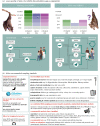Robust evidence for bats as reservoir hosts is lacking in most African virus studies: a review and call to optimize sampling and conserve bats
- PMID: 37964576
- PMCID: PMC10646460
- DOI: 10.1098/rsbl.2023.0358
Robust evidence for bats as reservoir hosts is lacking in most African virus studies: a review and call to optimize sampling and conserve bats
Abstract
Africa experiences frequent emerging disease outbreaks among humans, with bats often proposed as zoonotic pathogen hosts. We comprehensively reviewed virus-bat findings from papers published between 1978 and 2020 to evaluate the evidence that African bats are reservoir and/or bridging hosts for viruses that cause human disease. We present data from 162 papers (of 1322) with original findings on (1) numbers and species of bats sampled across bat families and the continent, (2) how bats were selected for study inclusion, (3) if bats were terminally sampled, (4) what types of ecological data, if any, were recorded and (5) which viruses were detected and with what methodology. We propose a scheme for evaluating presumed virus-host relationships by evidence type and quality, using the contrasting available evidence for Orthoebolavirus versus Orthomarburgvirus as an example. We review the wording in abstracts and discussions of all 162 papers, identifying key framing terms, how these refer to findings, and how they might contribute to people's beliefs about bats. We discuss the impact of scientific research communication on public perception and emphasize the need for strategies that minimize human-bat conflict and support bat conservation. Finally, we make recommendations for best practices that will improve virological study metadata.
Keywords: African Chiroptera; One Health; framing; virological metadata; virus–host relationship.
Conflict of interest statement
We declare we have no competing interests.
Figures


References
Publication types
MeSH terms
Grants and funding
LinkOut - more resources
Full Text Sources
Miscellaneous

